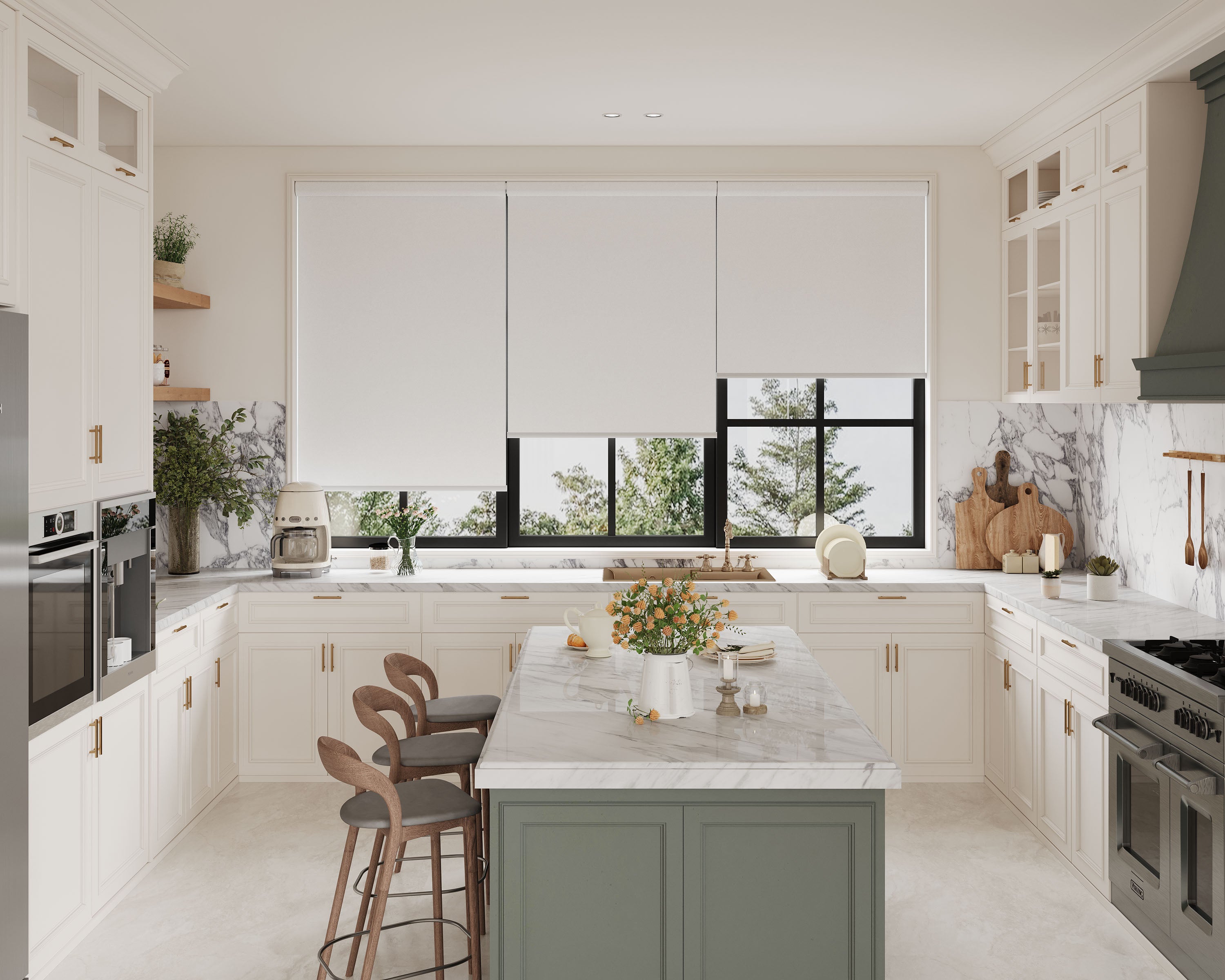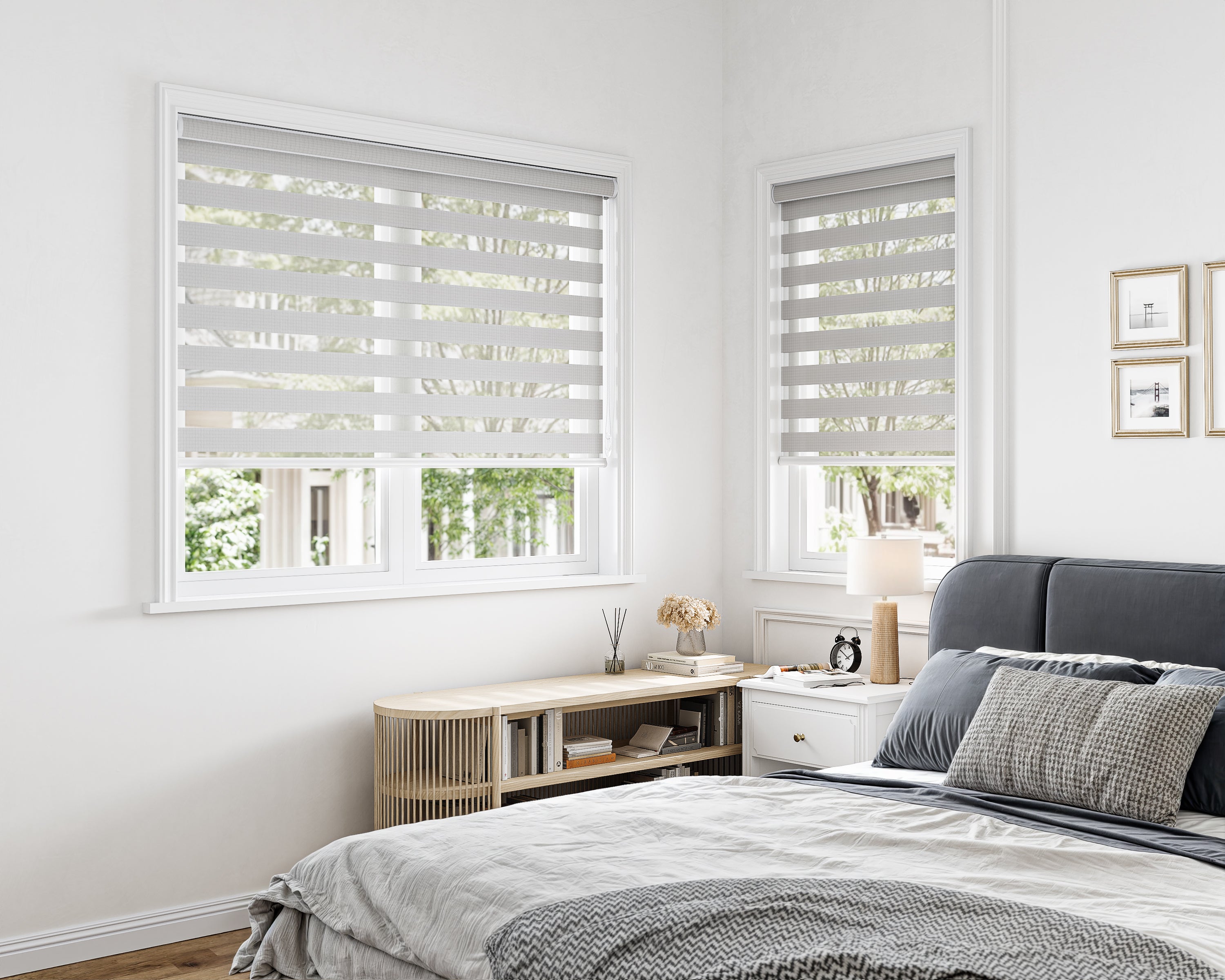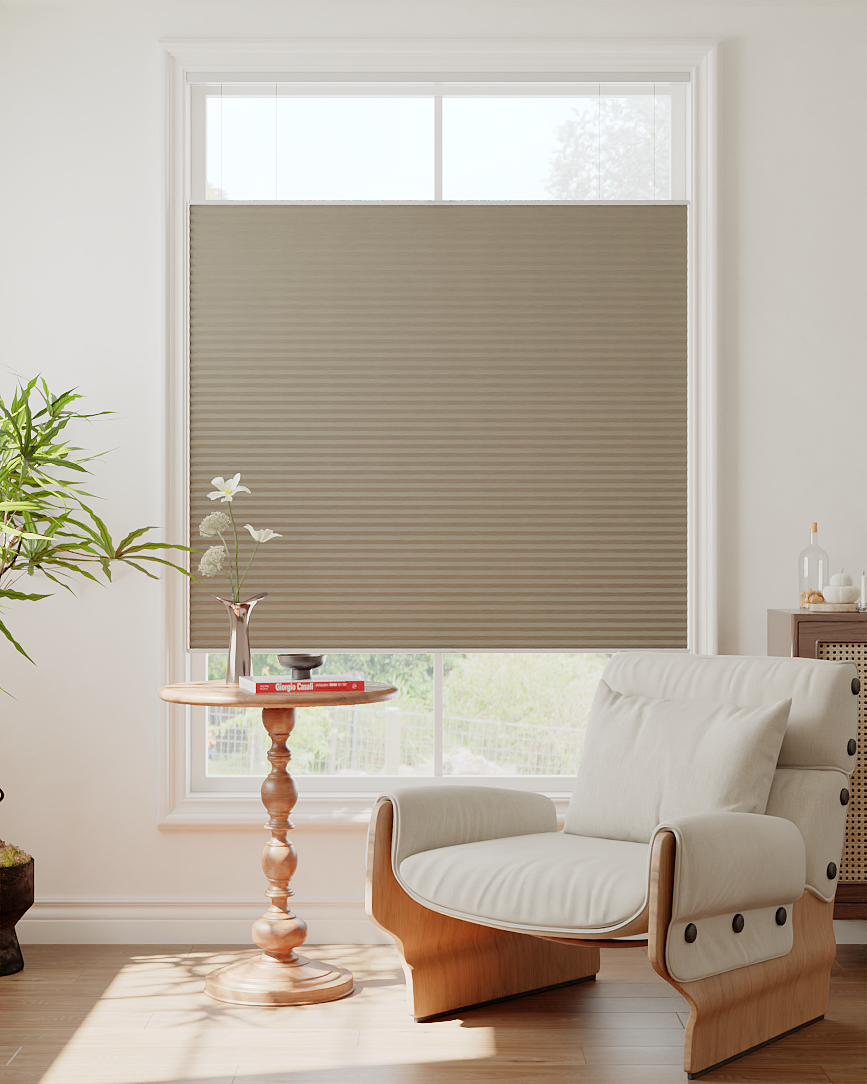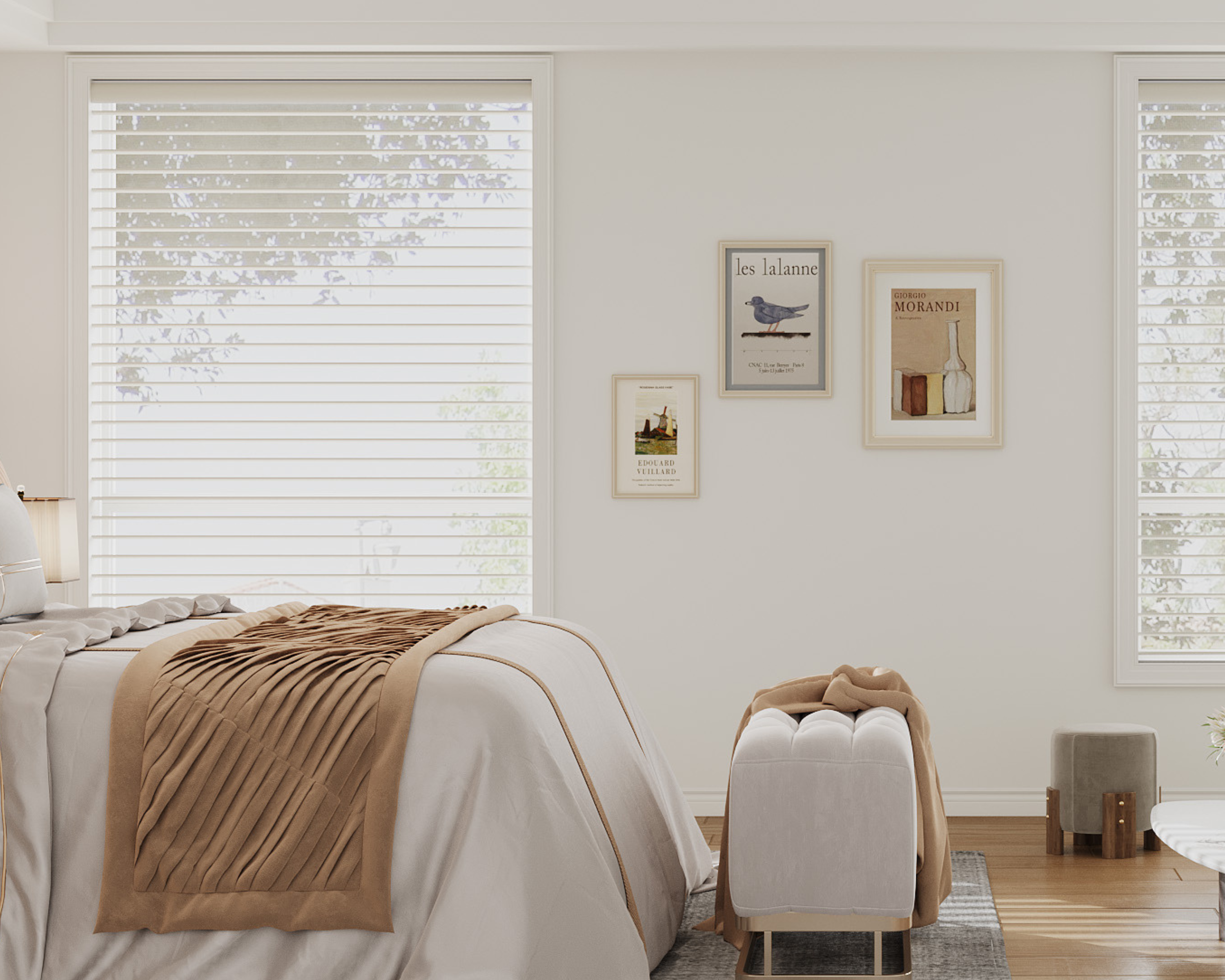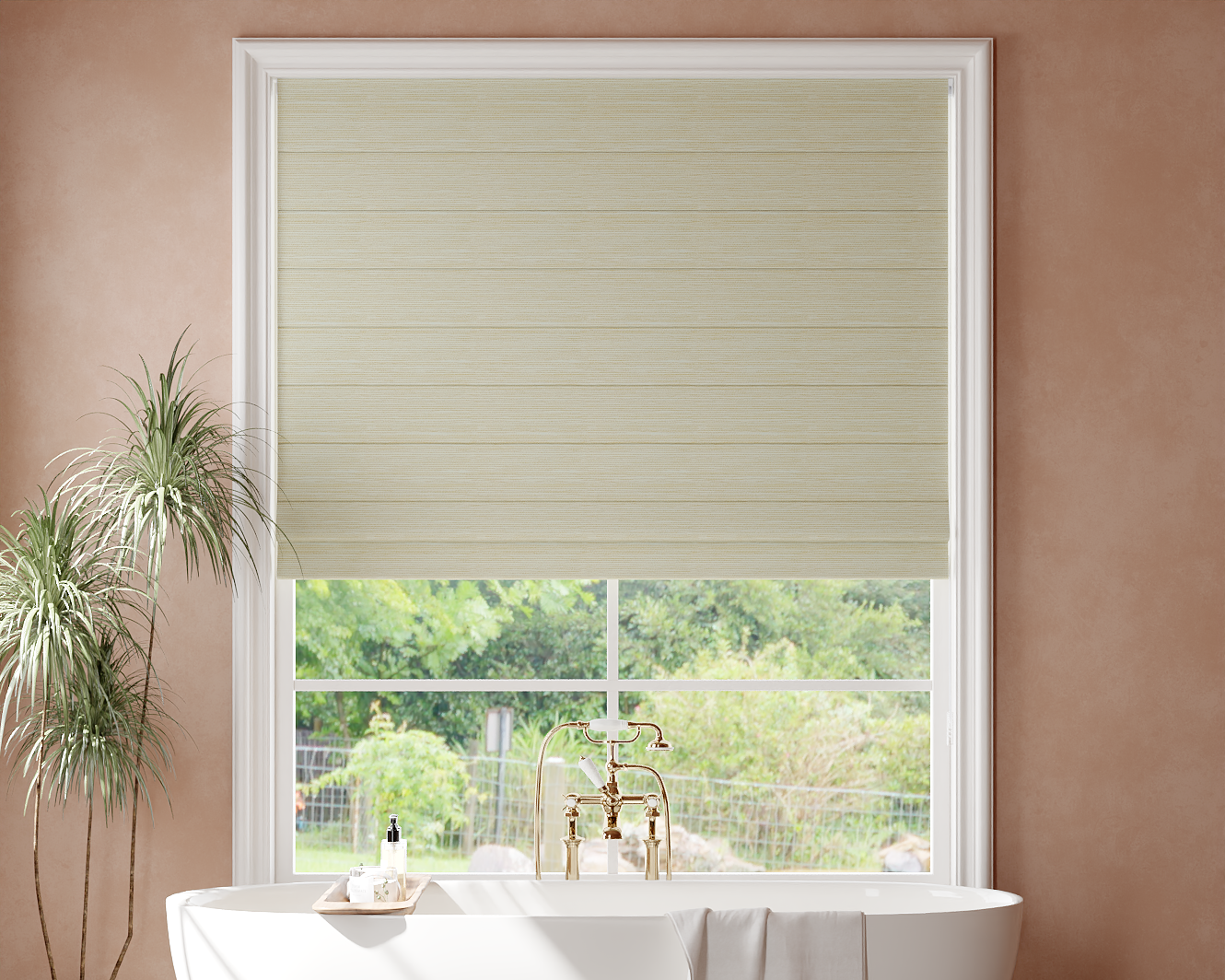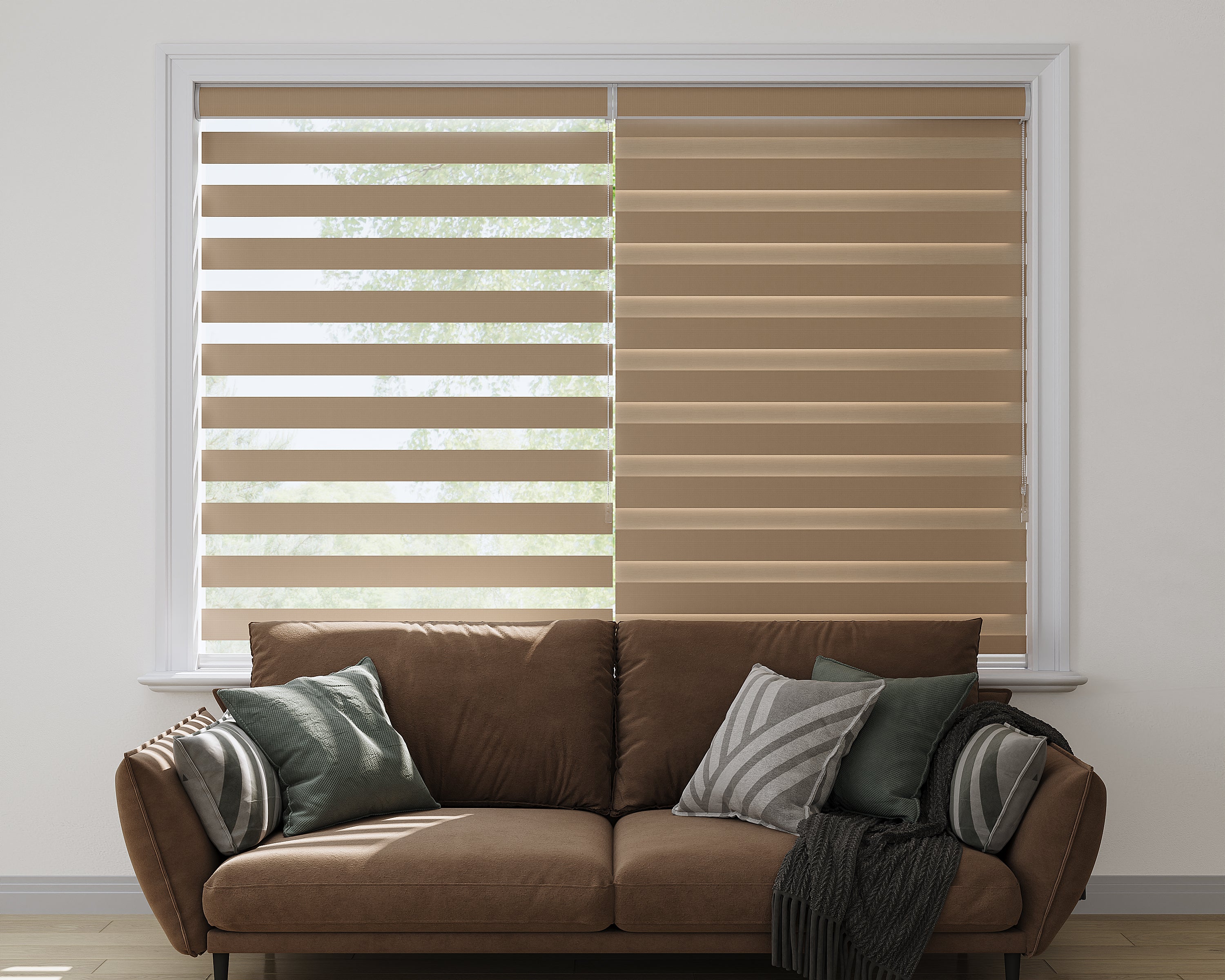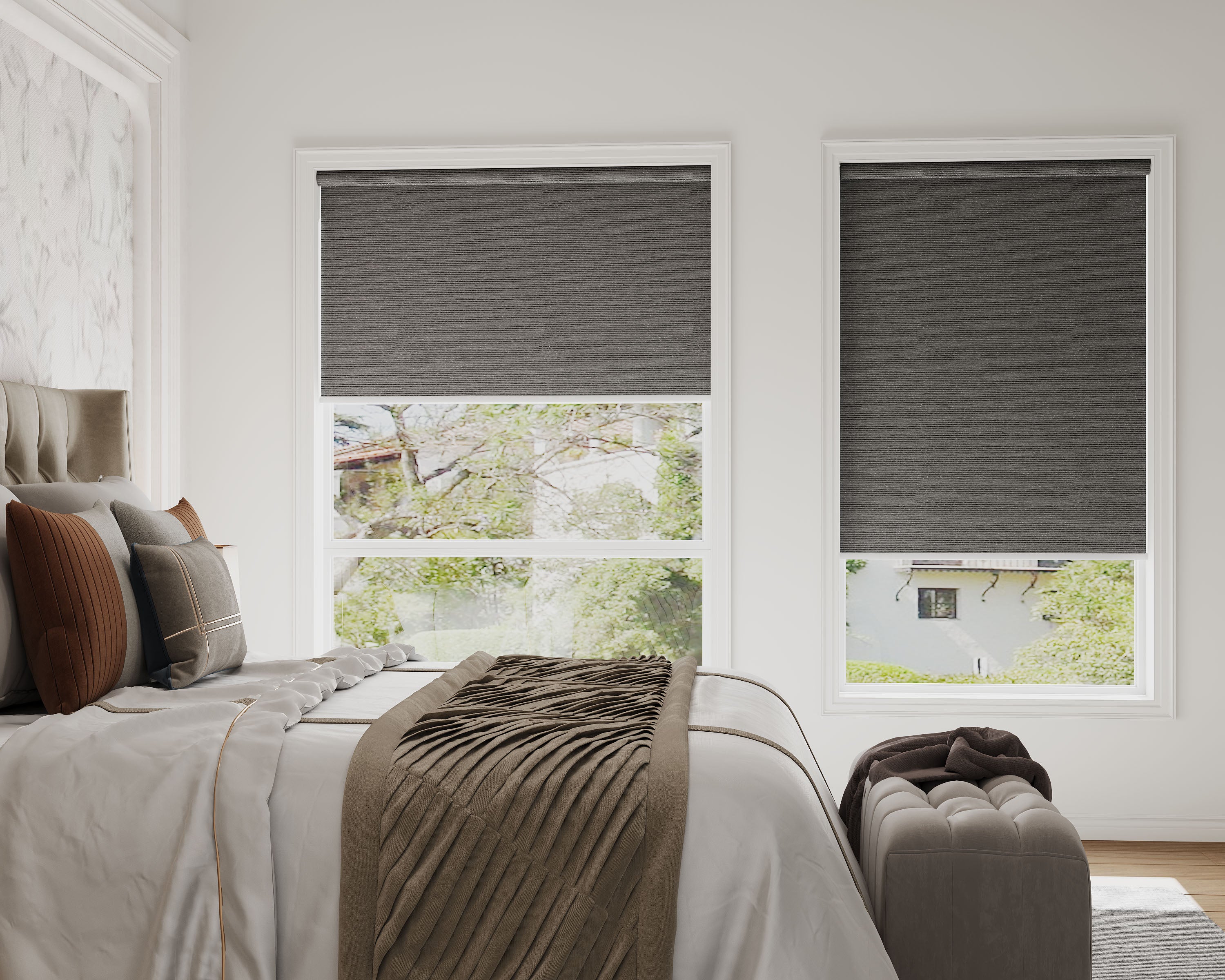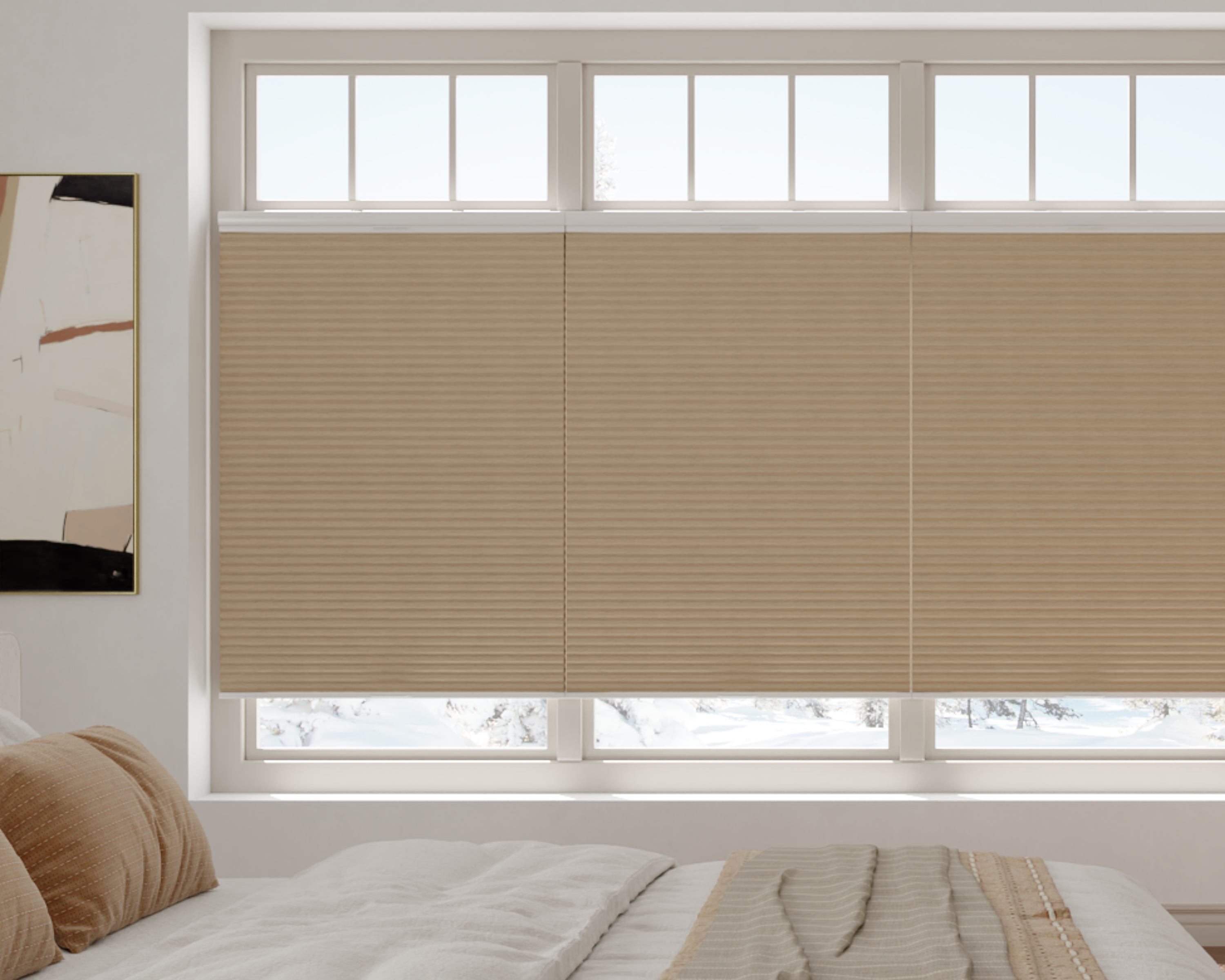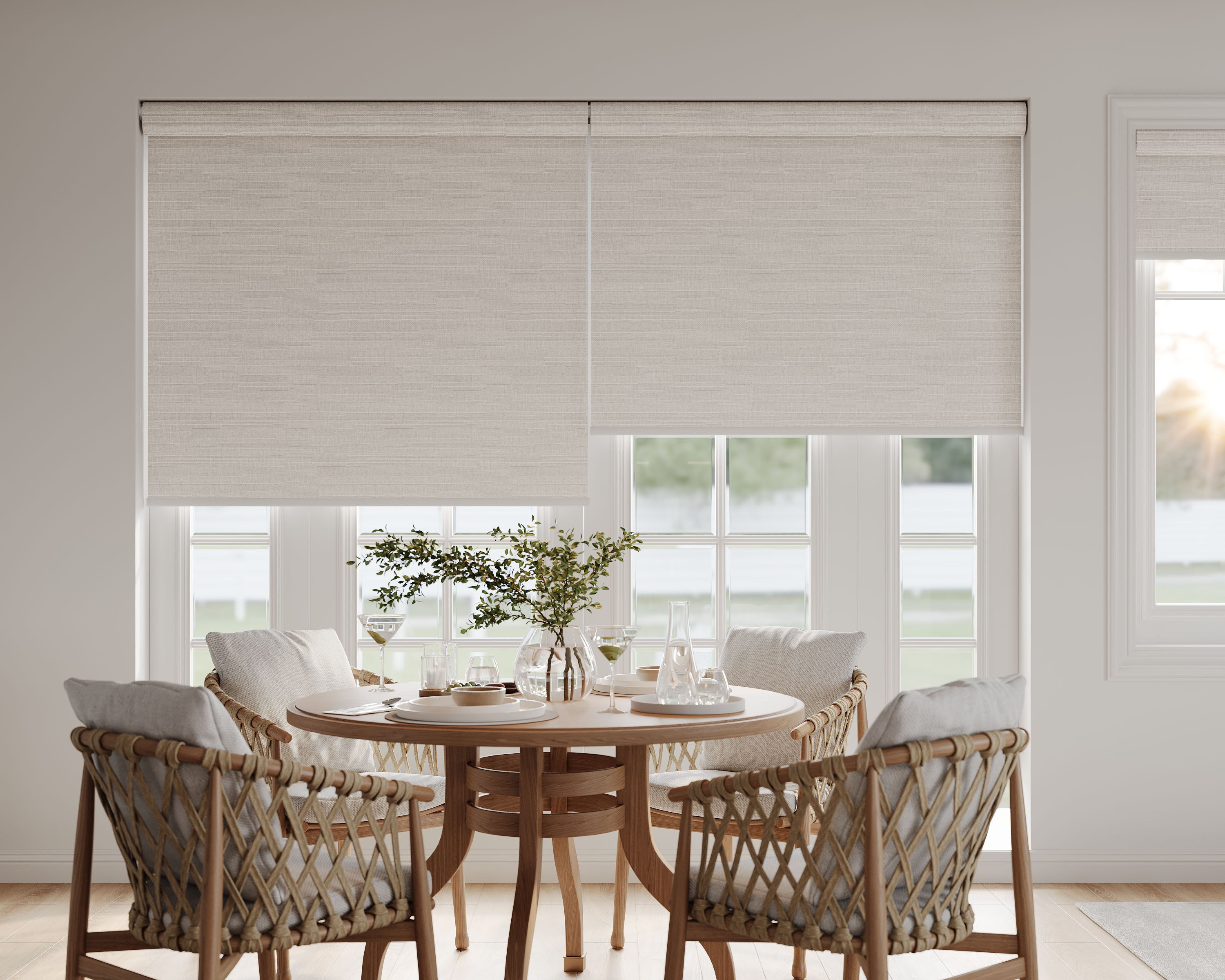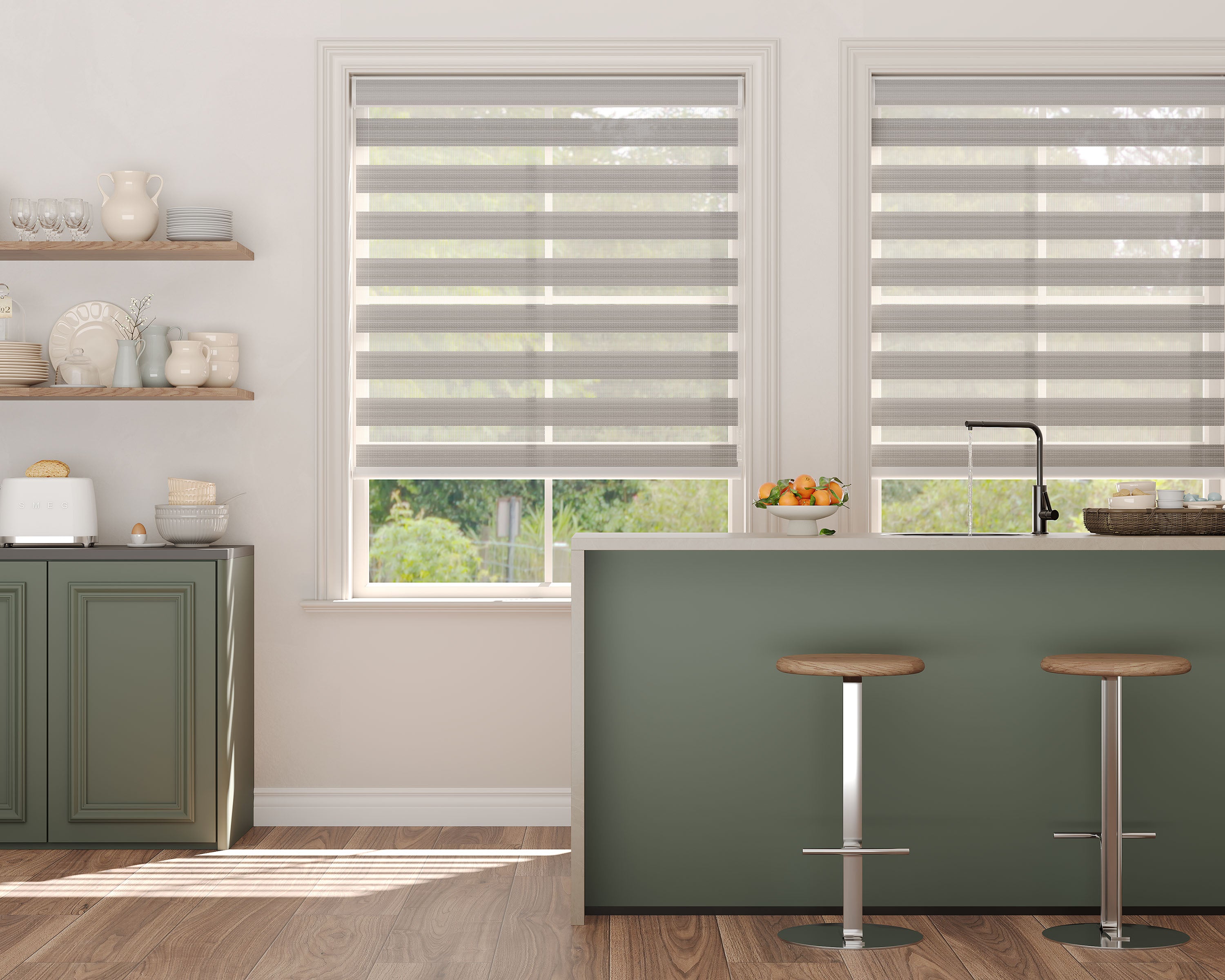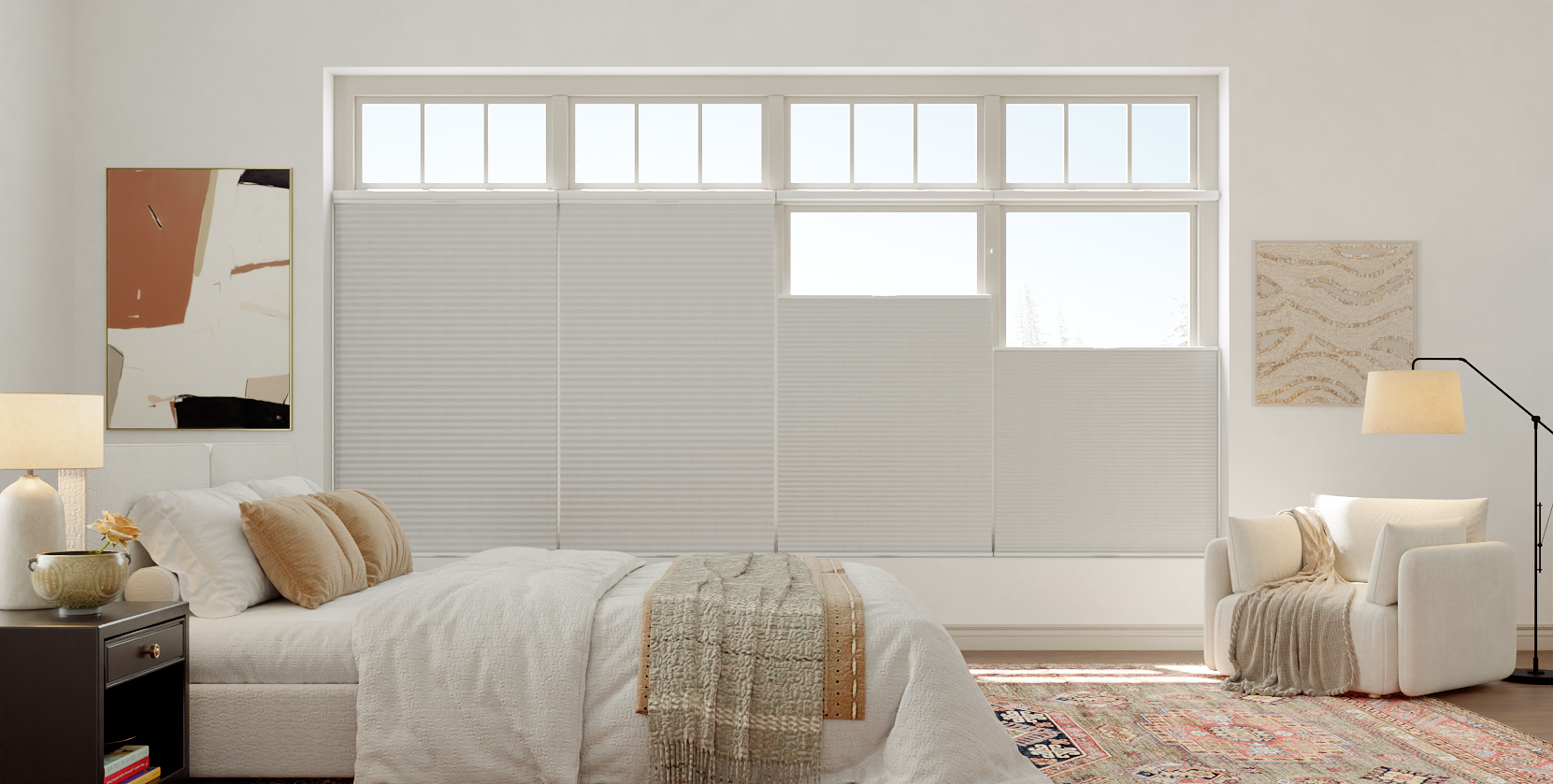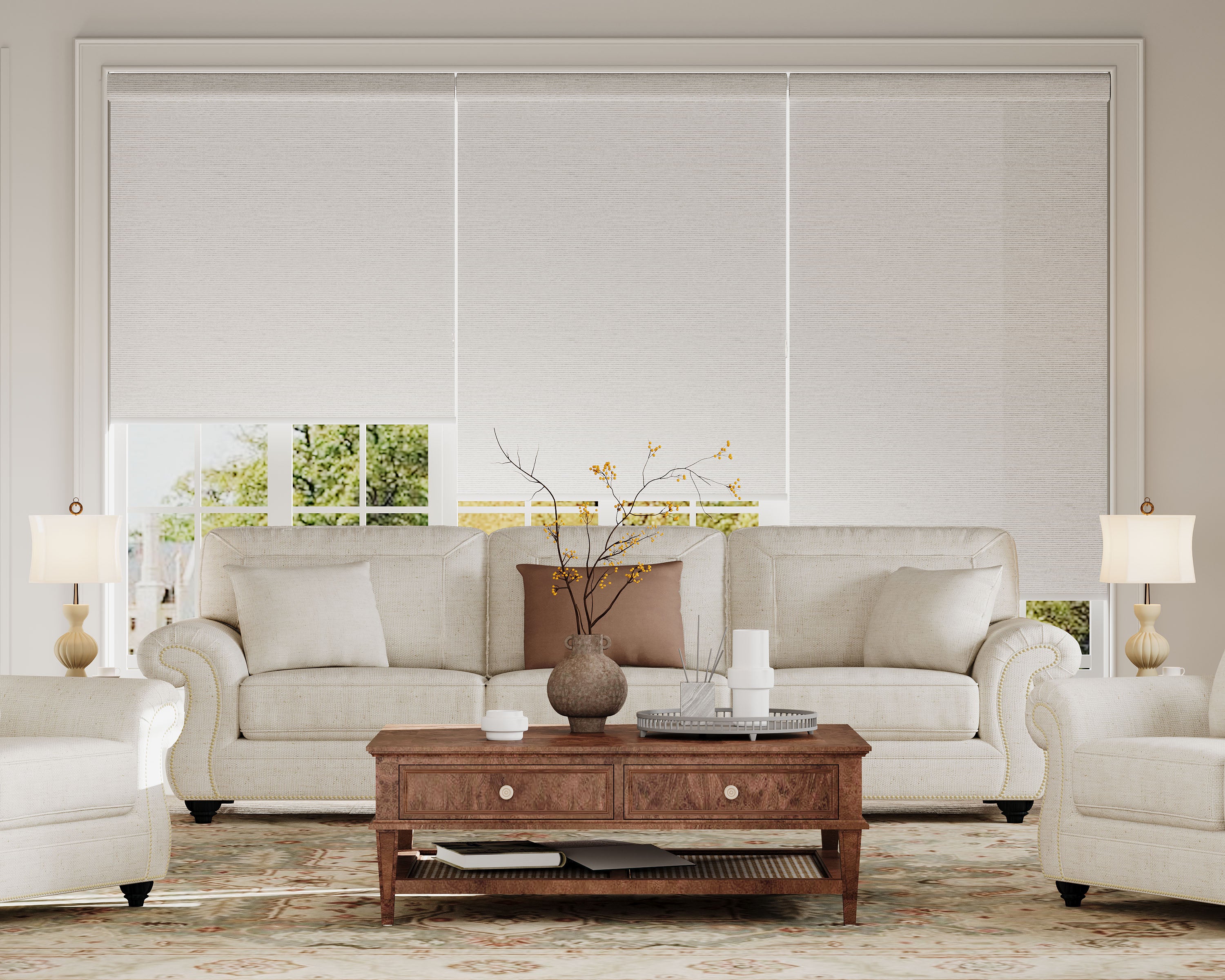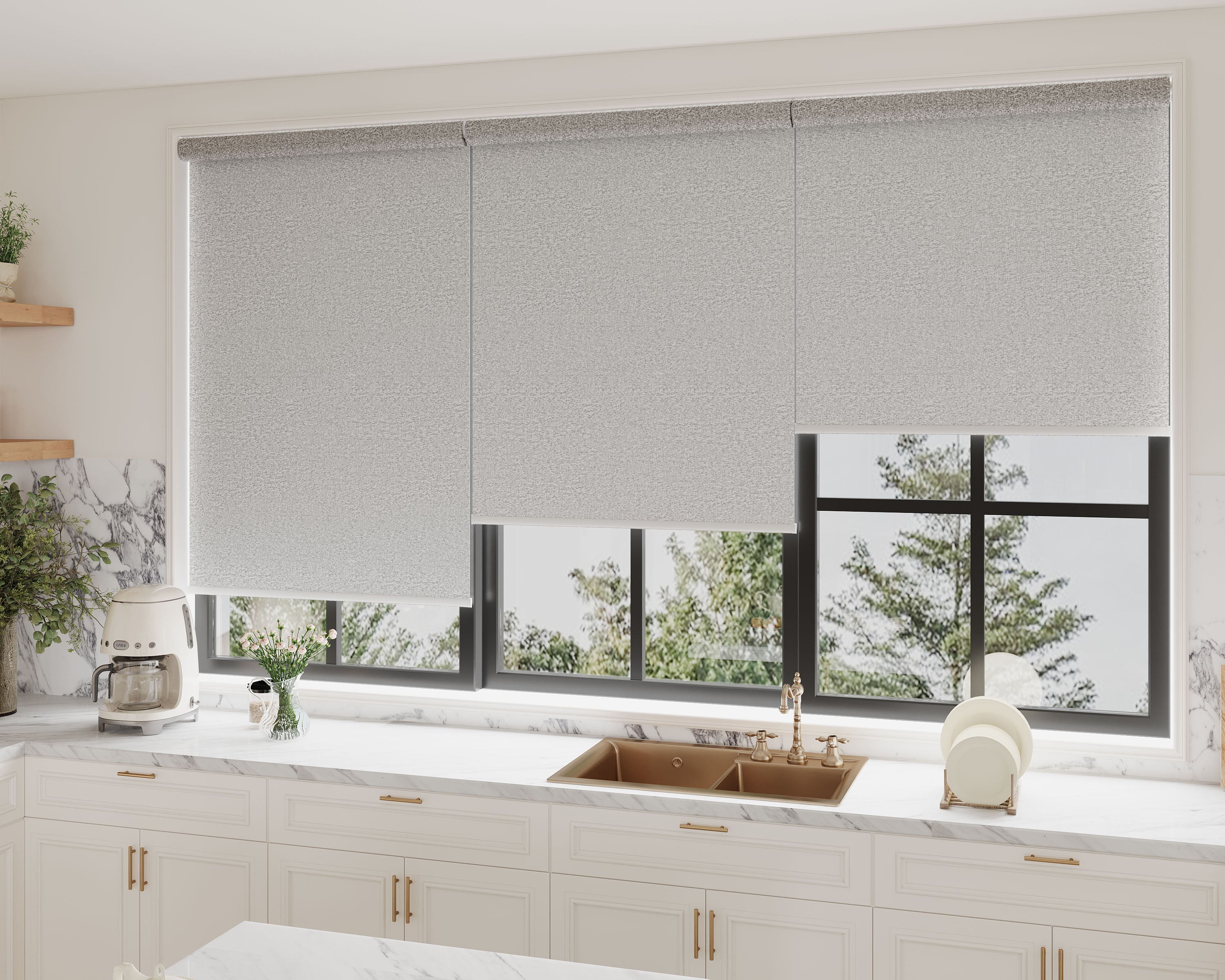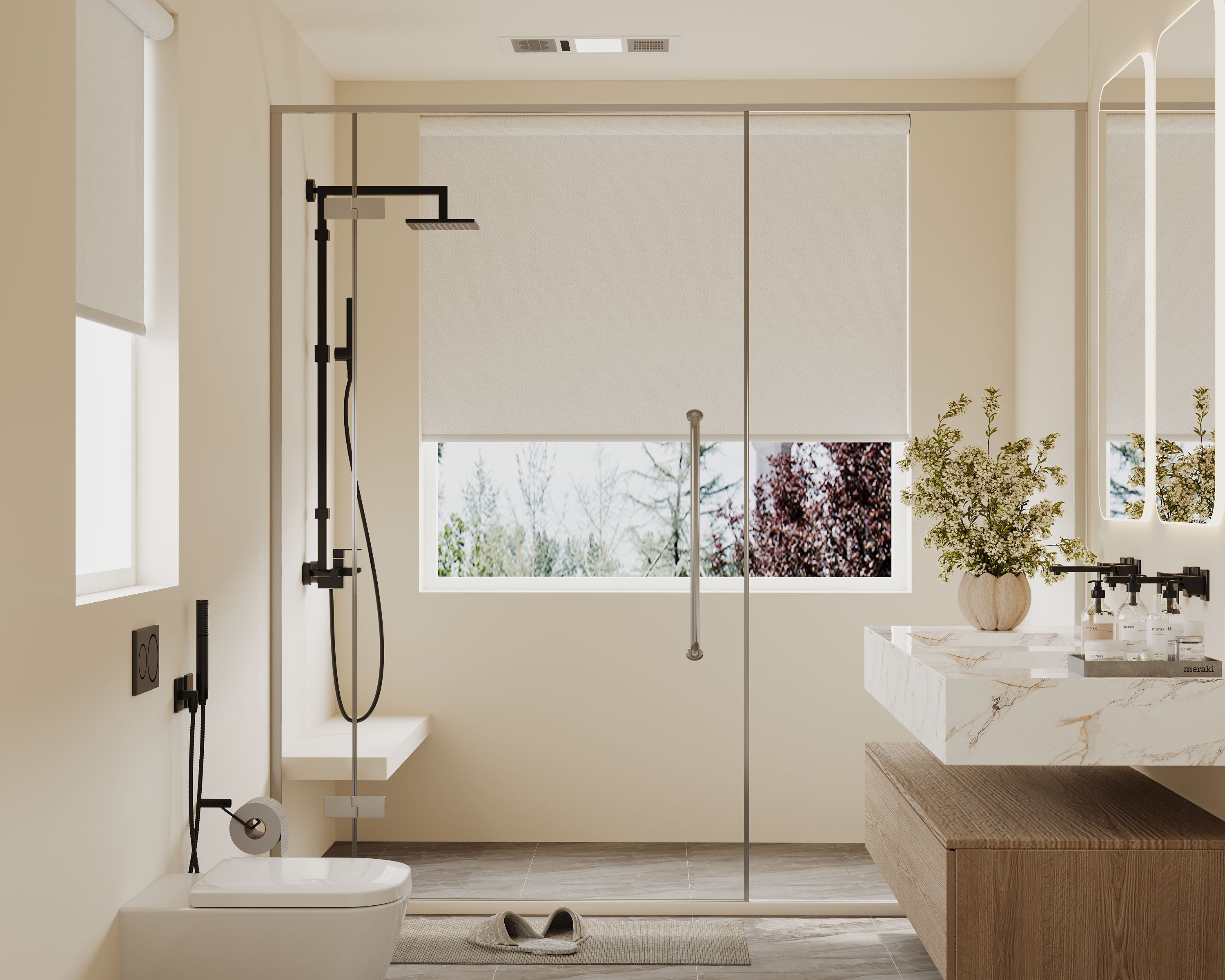Explore our top collections, including Roller Shades, Zebra Shades, and Blackout Shades.
When we’re designing a room, the feel of a fabric can completely change our space, whether it’s through cozy woven textures or sleek, smooth finishes. The right fabric texture—woven or smooth—sets the mood and function of a room, so knowing when to use each is key for a polished look. Woven fabrics bring warmth and depth, while smooth fabrics offer a crisp, clean vibe.
We’ve all seen how the touch and look of upholstery or curtains affect the whole design—not just comfort but also how the room comes together visually. Choosing between textures isn’t just about style; it’s about practicality, durability, and the mood we want to set.
Key Takeaways
- Fabric texture is a major factor in room design success.
- Woven and smooth fabrics each have distinct benefits.
- Choosing the right fabric comes down to room function and style goals.
Understanding Fabric Texture
Comparing fabric textures means looking at how materials are made, how they look, and how they feel. The right texture can boost a space’s style, change how a room feels, and even affect our comfort level.
Defining Woven and Smooth Fabrics
Woven fabrics are made by interlacing two or more sets of thread at right angles. This creates a visible texture, sometimes with raised patterns or an open weave.
Common examples: tweed, linen, and canvas. These fabrics have more structure and visual interest.
Smooth fabrics, by contrast, have a flat, even surface. They’re often made by tightly weaving very fine threads or by using finishes that minimize texture. Think satin, silk, or polished cotton.
Here's a quick reference:
| Fabric Type | Common Examples | Texture |
|---|---|---|
| Woven | Tweed, linen | Textured, with visible weaves |
| Smooth | Satin, silk | Flat, even, often shiny or matte |
Woven fabrics bring texture and depth; smooth fabrics create a sleek, clean finish.
How Texture Affects Visual Appeal
Texture changes how we see a space.
Woven fabrics add dimension and make a room feel cozy or layered. They work well in spaces where we want warmth and a relaxed vibe, like living rooms or bedrooms.
Smooth fabrics reflect more light and look sleeker. They can give a space a polished or modern edge. We often use them in formal areas or where we want a minimalist look.
Mixing textures—like a woven linen sofa with smooth velvet cushions—adds visual interest. It breaks up monotony and gives our rooms a curated, thoughtful feel.
The Role of Touch in Fabric Selection
Touch is a big reason we pick certain fabrics for our homes.
Woven fabrics usually feel nubby or textured, adding comfort to spaces where we relax. They’re forgiving and hide little messes or wear, so they’re family-friendly.
Smooth fabrics feel cool and luxurious under our skin. They’re great for drapes or bedding where we want a crisp, clean impression.
We should always consider who will use the space. Homes with pets or kids often benefit from forgiving, textured fabric. For a guest suite, smooth, elegant options might win out. The feel under our hands really makes a difference day to day.
Woven Fabrics: Characteristics and Benefits
Woven fabrics offer structure, personality, and reliable performance. They provide tactile interest and make a big impact, whether we’re outfitting windows, reupholstering a chair, or picking new cushions.
Distinctive Textures and Patterns
Woven fabrics stand out because of their visible threads, resulting in raised surfaces and distinct feels. From chunky tweeds to refined jacquards, we get everything from subtle interest to bold statements. The texture isn’t just for show; it adds real dimension that can soften a room or anchor the look of a space.
Layering woven fabrics invites visual and tactile warmth. Many woven textiles come with patterns like herringbone, chevron, or plaid that hide wear and bring character to high-traffic areas. These textures and designs break up flat surfaces and keep our spaces from feeling sterile.
Durability and Longevity
Woven fabrics are usually the go-to for toughness. The interlacing threads make them stronger and more resistant to stretching and sagging. We can count on them for everyday use—especially on pieces like sofas, dining chairs, or drapes that see a lot of action.
Maintenance is straightforward most of the time. Many woven fabrics can be vacuumed or spot-cleaned as needed, and the heavier options handle occasional mishaps better than their smooth competitors. The structure helps resist pilling and minor snags, which can extend the life of our favorite pieces. If we invest in quality woven upholstery, we're likely saving ourselves future repair or replacement headaches.
Applications in Home Décor
Woven fabrics work almost anywhere, but some spots really let them shine. They’re perfect for upholstery—think couches, sectionals, and headboards—where strength and style matter. We also find them in sturdy drapes or curtains, where their weight keeps folds crisp and offers privacy.
Accent pillows, throws, and blankets in woven textures can make a room feel curated and cozy. Even on lamp shades or as fabric wall panels, woven options bring depth and a handcrafted touch. For anyone wanting a custom, layered interior, a few well-placed woven pieces can make all the difference.
When to Use Woven Fabrics In Your Space
Woven fabrics excel at delivering tactile warmth and visual interest. They can make a room feel more lived-in and layered, especially when paired thoughtfully with other design choices.
Creating Cozy and Inviting Rooms
We reach for woven fabrics when we want a space to feel homey and approachable. The thicker texture of weaves, whether it’s chunky wool or classic tweed, gives throw blankets, pillow covers, and upholstery a physical presence that softens hard edges and warms up cool palettes.
Unlike smooth options, woven materials add depth without demanding attention. In living rooms, a nubby-woven sofa or set of accent chairs can encourage relaxing and lounging. On chilly mornings, a tightly woven area rug underfoot helps make the entire room feel more snug.
If we’re working with a space that feels cold or formal, like a new build or an all-white palette, woven fabrics add that extra layer of comfort without overcomplicating the design.
Layering With Other Textures
Using woven fabrics alongside other textures creates a balanced look. We love to mix woven throws and pillows with smoother surfaces like leather, glass, or glazed ceramics to keep things from feeling too “matchy-matchy.”
For example, a woven jute rug grounds a space with a natural touch, but pairing it with crisp cotton curtains or a velvet accent pillow makes the room feel more dynamic. The interplay between textured and non-textured elements keeps the eye moving.
Layering ideas:
- Pair woven upholstery with metal or wood furniture.
- Drape a knit throw over a leather chair.
- Combine woven baskets with glossy vases or lamps.
This strategy brings out the best in both woven and smooth materials.
Best Rooms for Woven Textures
Some rooms really shine with woven textiles. Living rooms and family rooms benefit from the added softness and durability, especially if there’s a lot of daily use. Bedrooms are another great spot; a woven bedspread or blanket gives our retreats a relaxed, restful vibe.
Dining rooms can also work, especially if we opt for woven placemats or upholstered chairs to lend comfort during long meals. Entryways, where first impressions count, feel warmer and more welcoming with a woven runner or bench cushion.
We might avoid heavily woven surfaces in kitchens or bathrooms since moisture and spills can be tough on them. But almost any other space can handle a bit of woven texture for comfort and style.
Smooth Fabrics: Features and Advantages
Smooth fabrics give us that clean, polished vibe and tend to fit beautifully with contemporary styles. They’re practical, easy to keep looking fresh, and offer a dependable base for minimal or simple spaces.
Sleek Finishes and Modern Looks
Smooth fabrics give furniture and drapes a crisp, uninterrupted appearance. With options like cotton sateen, velvet, and microfiber, these materials sit nicely on couches or chairs without extra texture to distract the eye.
Their flat surfaces reflect light in a way that makes colors pop and lines look sharper. For those of us who favor sleek, modern interiors, smooth fabrics help create that upscale, tailored finish. There’s also less visual noise, so our decor and statement pieces stand out more.
Here are a few benefits of smooth finishes:
- Clean lines: Support geometric or minimalist designs
- Polished appearance: Ideal for modern or transitional styles
- Color intensity: Smooth surfaces show off hues more vibrantly
Ease of Cleaning and Maintenance
Smooth fabrics are often the go-to pick for areas where spills and stains are a fact of life. Without raised fibers or intricate weaves, we can usually spot-clean or vacuum dirt away before it sets in. Microfiber, for instance, resists moisture and repels dust, which is honestly a relief during allergy season.
It’s a big plus for pet owners or families with kids — hair and crumbs tend to sit on top rather than get stuck in complex textures. Many smooth fabrics are either machine washable or respond well to damp cloths. Here’s a quick comparison table:
| Fabric Type | Stain Resistance | Cleaning Method |
|---|---|---|
| Microfiber | High | Damp cloth, vacuum |
| Leather | Very High | Wipe clean |
| Sateen/Cotton | Moderate | Machine wash |
Smooth Fabrics for Minimalist Interiors
When we design minimalist spaces, smooth fabrics become our best friends. The lack of texture helps keep rooms feeling calm and open, making even small spaces appear bigger. Fabrics like linen blends, light cottons, and sleek synthetics lay flat and don’t attract much attention.
This unobtrusive quality fits perfectly with simple color palettes and uncluttered layouts. We can combine different smooth materials without creating chaos, and mix them with harder surfaces like glass or metal for contrast. If we want a peaceful, put-together space without visual clutter, smooth fabrics get us there.
Choosing Smooth Fabrics for Your Design Vision
Smooth fabrics give our interiors a crisp, fresh look that lets light play across surfaces. They can be sleek and formal, bold and modern, or soft and understated, depending on how we use them.
Balancing Shine and Matte Finishes
Smooth fabrics come in a wide range of finishes, from high-gloss satin to soft, flat cotton. Choosing between these depends on how much light reflection we want in our space. Shine can add energy and drama, but too much might overwhelm a room.
Matte finishes are great for reducing glare and giving a quiet, subtle vibe. We often use them in rooms meant for relaxation, such as bedrooms or peaceful dens. Shiny fabrics work well on accent pieces or in formal settings like dining rooms.
When mixing smooth fabrics, we like to balance shine and matte. For example:
| Room | Fabric Suggestion | Finish Type |
|---|---|---|
| Living Room | Velvet Sofa | Matte |
| Dining Room | Silk Drapes | Glossy |
| Bedroom | Cotton Bedding | Matte |
This mix creates depth without overwhelming the overall look.
Best Uses in Contemporary Spaces
Smooth fabrics really shine (pun intended) in contemporary design. Their crisp textures reinforce clean lines and uncluttered layouts. Think about minimalist rooms with leather sofas or sleek linen curtains, keeping things open and modern.
We use smooth fabric for large areas—like sofas, benches, or floor-to-ceiling drapes—to encourage a tidy, streamlined effect. Smooth fabrics also hold bold colors and sharp prints with clarity, making them ideal for feature pieces.
Contemporary spaces often call for a simple, neutral palette. Smooth fabrics in taupe, white, or slate ground the space and highlight architectural features. They reflect natural and artificial light evenly, keeping the space bright and inviting.
Pairing Smooth Fabrics With Bold Accents
Smooth fabrics set the stage for bold decor. When we use velvet or faux leather upholstery, it’s easy to toss on patterned pillows or a chunky knit throw for a quick hit of texture. The sleek base really lets those accents stand out without making things look crowded.
Pairing smooth upholstery with bright rugs, graphic art, or metallic bits? That’s a classic move. Imagine a linen sofa with cobalt blue cushions—your eyes go straight there. The contrast amps up both the texture and the color.
We usually stick to two or three main accent colors or finishes so the look doesn’t get chaotic. That way, swapping out pillows or throws for a seasonal change stays simple.
Comparing Woven vs. Smooth Fabrics
Choosing between woven and smooth fabrics? Texture jumps out right away, shaping both style and function. Each has its own strengths for different tastes, lifestyles, and budgets.
Aesthetic Appeal and Mood Setting
Woven fabrics like tweed or basketweave have visible texture and depth. They make a space feel cozier, more relaxed. Sofas, chairs, or throw pillows in a nice weave add instant interest.
Smooth fabrics—think sateen or microfiber—deliver a crisp, clean look. They work great in modern or minimalist rooms where you want simple lines and a bit of subtle shine. Light plays off smooth fabrics differently, sometimes giving them a gentle sheen.
If we want warmth and that comfy, lived-in feeling, woven’s the way to go. For a sharp, polished vibe, smooth usually wins out. Mixing both in one room? Honestly, that’s often the sweet spot—keeps things from feeling flat.
Practical Considerations for Everyday Living
Woven fabrics do a surprisingly good job hiding stains and daily wear, thanks to their texture. That makes them smart for busy homes, high-traffic spots, or anywhere you’ve got pets or kids dropping crumbs.
Smooth fabrics are a breeze to clean, since dust and debris don’t get stuck in the surface. They’re perfect if you want low-maintenance or have allergies. But, heads up—velvet or silk can show marks, pet hair, or pressure spots more than you might like.
Climate matters too. Woven feels warmer and adds softness in chilly rooms, while smooth fabrics tend to feel cooler—handy for those muggy summers or homes that heat up quickly.
Budget and Longevity Factors
Woven fabrics, especially those made from tough fibers like polyester blends or heavy cotton, tend to last longer. Their structure stands up to pilling, stretching, and everyday messes. If you want your decor to go the distance, woven’s often worth the investment.
Smooth fabrics run the gamut on price and durability. Basic microfibers are easy on the wallet, but luxe options like silk or top-notch velvet can get pricey. Here’s a quick breakdown:
| Attribute | Woven | Smooth |
|---|---|---|
| Avg. Price Point | Medium to high | Low to high |
| Durability | High (most types) | Moderate to high |
| Maintenance | Moderate | Easy (most types) |
Your pick really depends on how much action the area sees, how much cleaning you’re willing to do, and what you’re okay spending upfront.
Decision-Making Tips for Fabric Texture
Picking between woven and smooth fabrics isn’t just about looks. It should fit your daily habits, design goals, and what feels good to the touch.
Assessing Lifestyle and Usage
How do you actually use your space? If it’s a busy spot or you’ve got kids and pets, durability matters most. Woven fabrics usually hide stains and stand up to wear better than most smooth ones.
For guest rooms or low-traffic areas, smooth fabrics like sateen or velvet bring in that sleek, untouched look. Cleaning habits play a role too. Woven blends often shrug off spills and hold up to repeated washing, while some smooth fabrics can snag or lose their shine.
Here’s a quick side-by-side:
| Space Type | Best Texture | Reason |
|---|---|---|
| Family Room | Woven | Hides wear, easier upkeep |
| Formal Living Room | Smooth | Looks refined, less use |
| Kids’ Playroom | Woven | Tougher, simple to clean |
Aligning Texture With Design Goals
What kind of vibe do you want? Woven textures make a room feel inviting and layered. Chunky knits, linen blends, textured cotton—they all add warmth and dimension.
Smooth fabrics, though, give off elegance and airiness. Velvet cushions set a posh tone, while sleek cotton or microfiber feels clean and modern. Mixing both? That keeps things lively—think a woven sofa with smooth pillows for balance.
Using texture on purpose bridges the gap between casual and refined. Are you after cozy or glam? That one call shapes everything else.
Experimenting With Samples
Trying samples at home changes everything. Touch matters—a fabric that looks great in a store might feel scratchy or too delicate on your sofa.
Scatter samples around the house: drape them over chairs, sit on them, spill a little water, maybe let the dog test them out. This low-pressure trial shows how a fabric stands up to real life.
Mixing samples side by side also helps you see which textures actually work together. Lighting can shift things—a woven fabric in sunlight might reveal patterns you didn’t spot in the store.
Frequently Asked Questions
Fabric texture shapes how we see and feel a space. Choosing woven or smooth changes the mood, comfort, and practicality of any room.
What's the impact of fabric texture on the overall look and feel of a room?
Texture changes both the look and the feel of a room. Woven fabrics add depth, warmth, and dimension. Smooth fabrics make things feel modern and streamlined. Texture also affects how light and shadow move across a surface, shifting the room’s vibe.
How can I use textured fabrics to enhance a space's aesthetic?
Textured fabrics draw the eye, create contrast, and add visual interest. Layering cushions and throws in different weaves or materials personalizes a space without making it too busy. Sometimes, swapping out a few flat fabrics for textured ones totally changes a room’s mood.
What textures in fabrics are best for creating a cozy atmosphere?
For cozy, we usually reach for chunky knits, velvets, bouclé, and heavy weaves. They catch light softly and feel inviting. These fabrics make you want to curl up—think plush armchairs or thick throws.
Can you mix different textures within a single design theme?
Absolutely, mixing textures makes a space feel more curated and alive. Stick to a cohesive color palette or overall style, and combining smooth and woven fabrics works beautifully. A linen sofa with velvet cushions or a leather chair with a knitted throw keeps things interesting.
What are the practical considerations when choosing between woven and smooth fabrics for upholstery?
Woven fabrics hide wear, dirt, and pet hair better thanks to their texture. Smooth fabrics, though sleek, may show stains or scratches faster. We always weigh style against durability and maintenance before making a call.
In terms of maintenance, how do woven and smooth textures compare?
Smooth fabrics? Super easy to wipe down, though every little spill or fingerprint just pops right out at you. Woven ones, on the other hand, might grab onto dust a bit more, so you'll need to work a touch harder to keep them spotless. But honestly, they hide everyday messes like a charm. So, if you know your sofa's in for a lot of action—or cleaning—it's worth thinking about what matters more to you.

